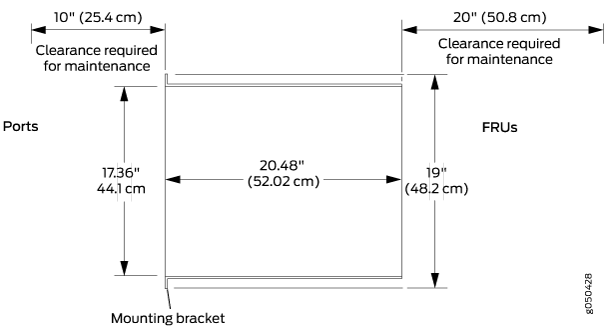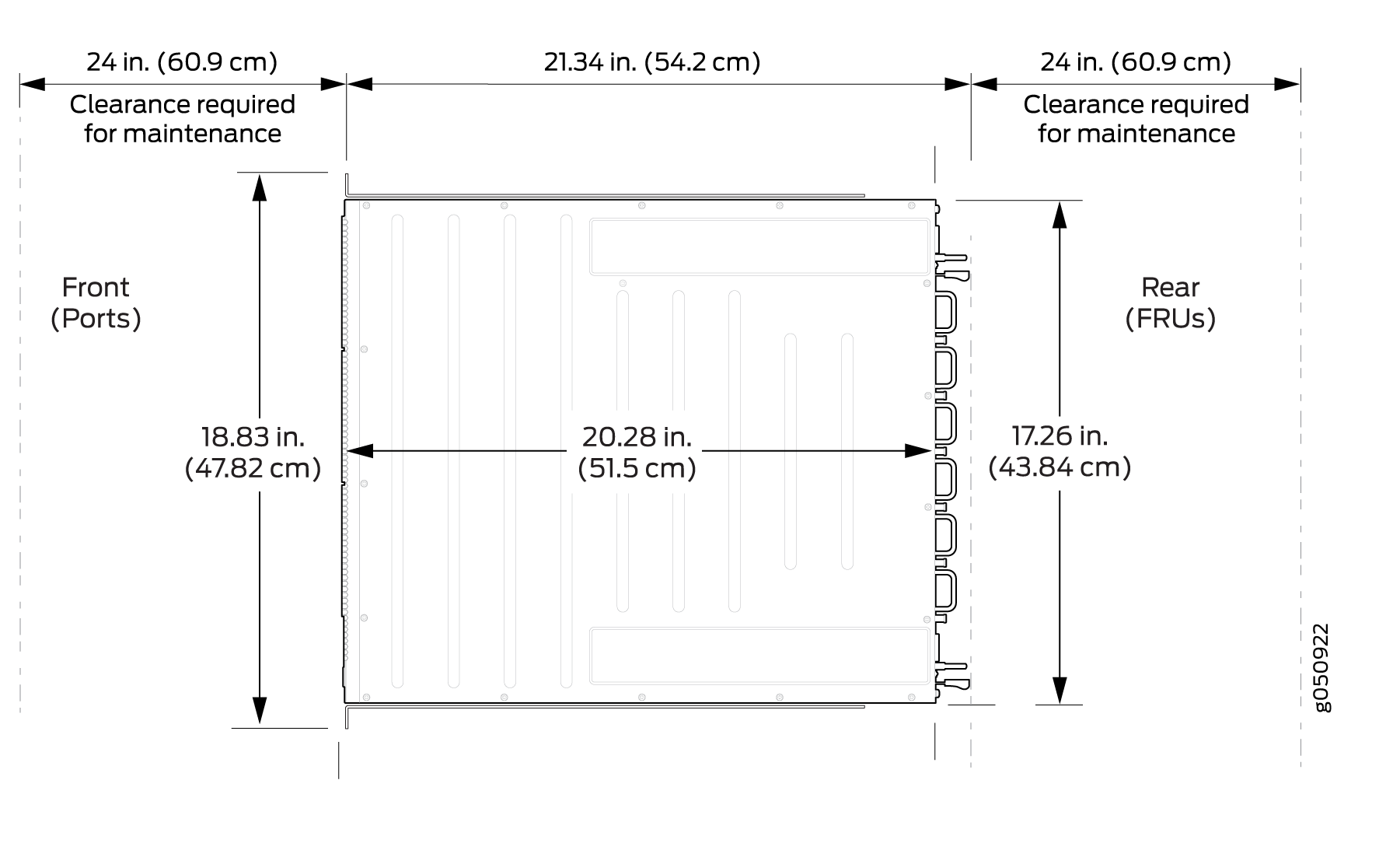QFX5200 Site Guidelines and Requirements
QFX5200 Environmental Requirements and Specifications
The switch must be installed in a rack or cabinet. It must be housed in a dry, clean, well-ventilated, and temperature-controlled environment.
Follow these environmental guidelines:
The site must be as dust-free as possible, because dust can clog air intake vents and filters, reducing the efficiency of the switch cooling system.
Maintain ambient airflow for normal switch operation. If the airflow is blocked or restricted, or if the intake air is too warm, the switch might overheat, leading to the switch temperature monitor shutting down the device to protect the hardware components.
Table 1 provides the required environmental conditions for normal switch operation.
Description |
Model |
Tolerance |
|---|---|---|
Altitude |
QFX5200-32C and QFX5200-32C-L |
No performance degradation to 6,562 feet (2000 meters) |
QFX5200-48Y |
No performance degradation to 13,000 feet (3,962 meters) |
|
Relative humidity, operating |
QFX5200-32C and QFX5200-32C-L |
Normal operation ensured in relative humidity range of 5% through 90%, noncondensing
|
QFX5200-48Y |
Normal operation ensured in relative humidity range of 5% through 93%, noncondensing for airflow out (AFO) models and 10% through 93%, noncondensing for airflow in (AFI) models |
|
Temperature |
QFX5200-32C and QFX5200-32C-L |
|
QFX5200-48Y |
|
|
Seismic |
QFX5200 all models |
Designed to comply with Zone 4 earthquake requirements per NEBS GR-63-CORE, Issue 3. |
Install QFX Series devices only in restricted areas, such as dedicated equipment rooms and equipment closets, in accordance with Articles 110-16, 110-17, and 110-18 of the National Electrical Code, ANSI/NFPA 70.
General Site Guidelines
Efficient device operation requires proper site planning. For the device to operate properly, you must ensure maintenance and proper layout of the equipment, rack or cabinet, and wiring closet.
To plan and create an acceptable operating environment for your device and prevent environmentally caused equipment failures:
Keep the area around the chassis free from dust and conductive material, such as metal flakes.
Follow the prescribed airflow guidelines to ensure that the cooling system functions properly. Ensure that the exhaust from other equipment does not blow into the intake vents of the device.
Follow the prescribed electrostatic discharge (ESD) prevention procedures to prevent damaging the equipment. Static discharge can cause components to fail completely or intermittently over time.
Install the device in a secure area, so that only authorized personnel can access the device.
QFX5200 Grounding Cable and Lug Specifications
To ground a QFX5200, connect a grounding cable to earth ground and then attach it to the chassis protective earthing terminals. See Connect the QFX5200 to Earth Ground.
To comply with GR-1089 requirements, all intra-building copper cabling used for SFP+ and QSFP+ ports must be shielded and grounded at both ends.
Before switch installation begins, a licensed electrician must attach a cable lug to the grounding cables that you supply. A cable with an incorrectly attached lug can damage the switch.
Before connecting the switch to earth ground, review the following information:
The grounding lug required for a QFX5200-32C or a QFX5200-32C-L is a Panduit LCD10-10A-L or equivalent (not provided). The grounding lug should accommodates 14–10 AWG (2–5.3 mm²) stranded wire. The grounding lug required for a QFX5200-48Y is tin-plated brass 4.3 mm ring terminal that supports 18–14 AWG (0.8-2 mm²) and an M4 screw.
The grounding cable that you provide for a QFX5200 must be 14 AWG (2 mm²), minimum 90° C wire, or as permitted by the local code. If you are using the alternate method of grounding the chassis on a QFX5200-32C-DC system, the recommended grounding cable is 12 AWG (2.5 mm²) standard wire, 90° C wire or heavier.
For QFX5200-32C or a QFX5200-32C-L, ensure you have two SAE 10-32 washers and screws to attach the cable and bracket (not provided).
QFX5200 Clearance Requirements for Airflow and Hardware Maintenance
When planning the site for installing a QFX5200, you must allow sufficient clearance around the installed chassis (see Figure 1 and Figure 2).


-
For the cooling system to function properly, the airflow around the chassis must be unrestricted. See QFX5200 Cooling System Description for more information about the airflow through the chassis.
-
If you are mounting a QFX5200 in a rack or cabinet with other equipment, ensure that the exhaust from other equipment does not blow into the intake vents of the chassis.
-
Leave at least 24 in. (61 cm) both in front of and behind the QFX5200. For service personnel to remove and install hardware components, you must leave adequate space at the front and back of the switch. NEBS GR-63 recommends that you allow at least 30 in. (76.2 cm) in front of the rack or cabinet and 24 in. (61 cm) behind the rack or cabinet.
QFX5200 Chassis Physical Specifications
The QFX5200 is a rigid sheet-metal structure that houses the hardware components. Table 2 summarizes the physical specifications of the QFX5200.
Product SKU |
Height |
Width |
Depth |
Weight |
|---|---|---|---|---|
QFX5200-32C and QFX5200-32C-L |
1.72 in. (4.3 cm) |
17.36 in. (44.1 cm) |
20.48 in. (52 cm) |
23.5 lbs (10.66 kg) |
QFX5200-48Y |
1.71 in. (4.34 cm) |
17.25 in. (43.81 cm) |
20.27 in. (51.48 cm) |
30.00 lbs (13.60 kg) |
Site Electrical Wiring Guidelines
Table 3 describes the factors you must consider while planning the electrical wiring at your site.
You must provide a properly grounded and shielded environment and use electrical surge-suppression devices.
Avertissement Vous devez établir un environnement protégé et convenablement mis à la terre et utiliser des dispositifs de parasurtension.
|
Site Wiring Factor |
Guidelines |
|---|---|
|
Signaling limitations |
If your site experiences any of the following problems, consult experts in electrical surge suppression and shielding:
|
|
Radio frequency interference |
To reduce or eliminate RFI from your site wiring, do the following:
|
|
Electromagnetic compatibility |
If your site is susceptible to problems with electromagnetic compatibility (EMC), particularly from lightning or radio transmitters, seek expert advice. Strong sources of electromagnetic interference (EMI) can cause:
|
QFX5200 Rack Requirements
QFX5200 switches are designed to be installed on four-post racks.
Rack requirements consist of:
Rack type
Mounting bracket hole spacing
Rack size and strength
Table 4 provides the rack requirements and specifications for the QFX5200.
Rack Requirement |
Guidelines |
|---|---|
Rack type |
Use a four-post rack that provides bracket holes or hole patterns spaced at 1 U (1.75 in. or 4.45 cm) increments and that meets the size and strength requirements to support the weight. A U is the standard rack unit defined in Cabinets, Racks, Panels, and Associated Equipment (document number EIA-310–D) published by the Electronics Industry Association. |
Mounting bracket hole spacing |
The holes in the mounting brackets are spaced at 1 U (1.75 in. or 4.45 cm), so that the switch can be mounted in any rack that provides holes spaced at that distance. |
Rack size and strength |
|
Rack connection to building structure |
|
QFX5200 Cabinet Requirements
You can mount the QFX5200 in an enclosure or cabinet that contains a four-post 19-in. open rack as defined in Cabinets, Racks, Panels, and Associated Equipment (document number EIA-310-D) published by the Electronics Industry Association.
Cabinet requirements consist of:
Cabinet size and clearance
Cabinet airflow requirements
Table 5 provides the cabinet requirements and specifications for the QFX5200.
Cabinet Requirement |
Guidelines |
|---|---|
Cabinet size and clearance |
The minimum cabinet size for accommodating a QFX5200 device is 36 in. (91.4 cm) deep. Large cabinets improve airflow and reduce the chance of overheating. |
Cabinet airflow requirements |
When you mount the switch in a cabinet, ensure that ventilation through the cabinet is sufficient to prevent overheating.
|
